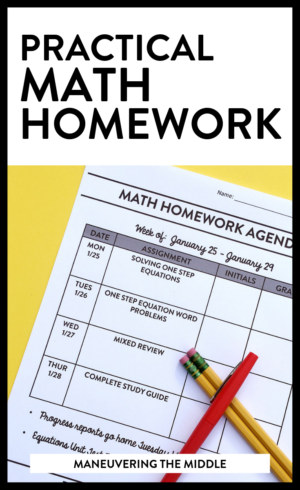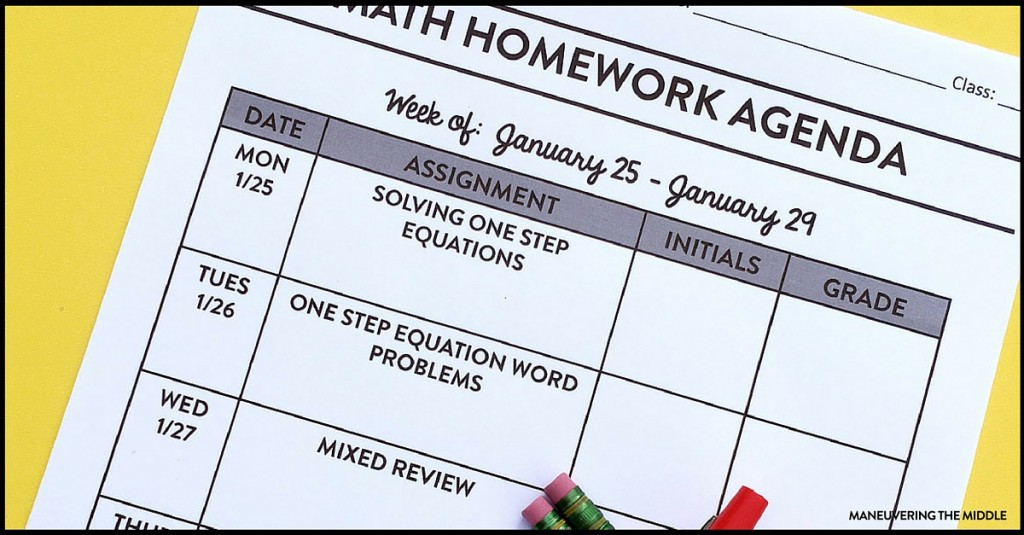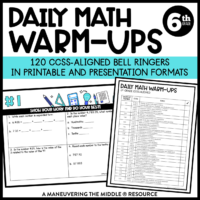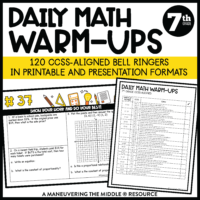Math homework is quite the debated topic these days. Some teachers and even schools have given up the idea of homework. I even worked at a school that attempted to standardize homework by assigning a different content area to each day of the week.
On my Facebook page, I have shared a few various viewpoints to homework: homework vs. no homework and a parent’s perspective.
Today, I am sharing a few tips for math homework and how I have utilized it in the past at various different schools. I like to call it practical or the “minimalist approach”.
What is the purpose of Math Homework?
I view homework as math practice. I make this illustration frequently to my students. Much like anything we want to succeed in, it requires practice. Basketball practice, football practice, video games, drawing, theater, even babysitting requires practice. As an adult I practice cooking, reading, blogging, exercising, teaching and parenting. There is always room for practice.
Homework is one way we practice; it keeps it fresh in our minds after a new lesson and helps us to keep it in our memory, so we don’t forget.
What is a Practical Amount of math Homework?
This is definitely up to you to choose what is best for your students. I personally limited homework to a maximum of 10 questions that students were capable of accomplishing within a 15-minute window. Depending on the concept, I would include roughly 6 skill-based problems and 4 or so word problems.
I firmly believe that consistency is key. Students should not have to think about whether or not they have homework; they should think about how much they have or what is yet to be accomplished. If you can train students to expect homework, then you have already worked to fight the struggle of getting it back completed.
How to Communicate Homework?
Communication is essential, it goes back to that famous saying, “it’s not what you say, but how you say it”! At the beginning of the year, you want to communicate the homework expectations to both parents and students. Students are provided with a weekly homework agenda and the corresponding handouts attached. I send a sample one home in my parent packet for parents to review, as well.
Then I give the same spiel for several weeks. “Homework is math practice just like any other sport. I care about your success in this class and your future success in life and believe that math will help you be successful. We work hard Monday through Thursday and then we take the weekend off.”
After a few weeks of being consistent, the moaning and groaning of homework dissipates.
How to keep up with homework?
The papers!!! They used to be the bane of my existence. 28ish papers flying at you, six different times a day, it is simply impossible to keep up with.
Then, I introduced the Homework Agenda. My life was revolutionized. The purpose of the agenda was three-fold:
- This eliminated the paper craziness and allowed me to only collect it once each week.
- Students were well aware of the expectations for the week and could keep everything together. At this age, there are students who are involved in many extra-curricular things and they loved knowing the assignments and what to expect at the beginning of the week.
- Parents knew what to look for and what was expected of their students. I am well aware that by middle school, students are more on their own and need to take responsibility for their assignments. I am a huge advocate of responsibility. However, there are students who need more support at home and whose parents are happy to help. This made it easy for them.

How to Use the Homework Agenda?
Each week I determined and prepped the assignments for the following week. I used my homework agenda template to update the dates and information, along with any class announcements. Then on Thursdays, my parent volunteer, would come in and copy the assignments.
On Monday, students received the Math Homework Agenda with subsequent assignments attached. I would aim to finish the lesson with 8-10 minutes of class, students would begin their assignment, and then whatever was not finished was to be completed by the following day.
The next day, students were to have their homework agenda out during the warm up. I would circulate and initial or stamp the Homework Agenda if it was complete. I created my own key that indicated whether the assignment was incomplete, late, or a student was absent (the day prior). This was written on their Homework Agenda, so I could see it on Friday when I entered grades.
At this point, you could go over the homework, answer questions, grade it as a class, etc. More on that later.
The same process was repeated on Wednesday. If Savina had her late work from the day before, I would make a note on her Homework Agenda.
Why the minimalist approach to homework works?
- You only have to collect the homework agenda once each week. Hallelujah.
- You only have to record grades (if you so choose) once each week. Sign me up.
- Excellent communication tool for parents, students, and teachers. Happy parents, happy teacher.
- Everything is together, students do not need anything else to complete the assignments. Let’s not make it harder than it needs to be.
- Students know what is expected of them each week. I firmly believe the vast majority (95%) of students want to meet expectations.
- It is consistent and predictable. Students thrive in consistent and predictable environments.
For further reading, check out these posts about homework:
I know this is a heated topic in education. I welcome respectful comments and questions in the comments. If you have something else that works well for you, I would love to hear it.







I love this idea! I just wish I could be planned ahead enough to have all the homework created for a whole week on Monday. Do you have students lose their packets in the middle of the week? What do you do about that as far as grading goes?
You could keep the papers in the classroom instead.
When you grade the homework in class, do the students who are missing homework stay in class?
Hi Rose! I have done both things: sending students out and having them stay in the room. I really didn’t like sending students out because it was time consuming and could end up being disruptive. So started using “late slips”. These were forms they had to complete while we were grading homework, fairly simple with the assignment name and reason they didn’t complete it. I would typically just put them in their individual student files, in the event of a parent conference or need for documentation. I also tried to really think of it more as math practice, so if they heard me answer a question about the homework, they were still being exposed to the content and would have to do it themselves at a later time. But, you could do whatever works best for you.
One problem I have is making sure that I am making things challenging enough to prepare them for high stakes test questions but not so hard that they will give up and not be successful. In our state, some practice test questions I have seen even make me stop and really think of what they want to know. I find myself overcompensating and trying to throw at them all types of questions they may see. For example, solving one step equation. I need to make sure that they can handle all the same steps with integers, decimals, fractions. If I break it down too much into just one lesson then I spend too much time on a topic and get way off track on the pacing guide. Any advice? Does your curriculum offer a pacing guide and will help me stay on target that way?
Thanks
Hi Shelby! I always thought that math was such a complex subject to teach because it is incredibly process oriented. Just like you mention, you are constantly building upon what students know and taking it to the next level. I would suggest really digging into what the standards are asking and working backwards from there. I have a post “How to Write a Unit Plan” that discusses this a bit. As far as the homework, I always liked to think of it as practice, not necessarily the game. So, I would prepare assignments that were in line with the lesson, but not necessarily the most rigorous, like you mention in the state assessments. I enjoyed working at that level during the class period and then over time asking students to do that on their own. Hope this helps!
Hi Noelle,
This is absolutely awesome and I plan to use it with my Middle Schoolers this year. My question is.. I see you put upcoming tests and quizzes at the bottom and important notes.. what goes at the very bottom? Do you ask parents to sign it as well? In my community we have a lot of absentee parents and we really struggle with getting parents involved in their students progress.. Do you get them to sign or just have it documented for PTI’s?
With my 7’s I teach them both Science and Math so I think I will be alternating the homework plan..
Thank you so much! I put tutorial information at the very bottom, since that stays the same all year. You could include your email or school phone number for parents to reference. When I taught 6th grade, I offered a few bonus points for parent signatures. By 8th grade, it became optional or could just be used for a student who was struggling. Have a great year!
Hi Noelle,
I just downloaded your 6th grade bundle. I am so excited! I wanted to know how you implement your HW. I notice that there are HW assignments that match up with the student handouts, as well as the 120 day HW set. Can you explain how you used each resource as HW.
Thank you
Hi Nicol! The homework that goes with each unit is aligned to the lesson and would be my go to choice. The 120 day set could really be used in any capacity because it is flexible and provides a spiral review. Many teachers have mentioned using it as reviews, with tutoring or small groups, and as a test prep. Hope that gives you some ideas. Feel free to email me if you have any more questions. Thanks!
What is the font that you use in this document? The script like font. I think I remember seeing it listed somewhere, but I can’t seem to find it.
It is called KG Always a Good Time. Thanks!
What do you do with your students’ graded papers? In our school, some teachers have math binders that the students keep in class. Another teacher uses folders that the students take out and put away each day.
The school district I taught in before required teachers to keep a folder of a “sample” of graded assignments that must match that assignment in the gradebook. There was always the fear that if papers were handed back, the low grades would be thrown away.
Thank you.
Hi, Marilyn! My school was similar. We kept graded work in a binder in school for reference.